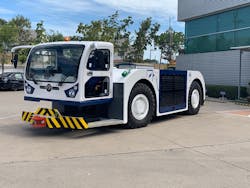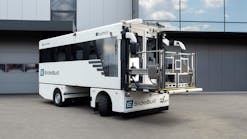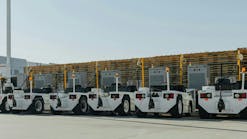Electric vehicles are not a “Back to the Future” dream anymore. They can be found worldwide and new charging stations to power them are popping up every day. For the ground support industry, electric vehicles are beginning to enter the market space and offer a green option to help professionals save time, money and emissions.
Australian-based Bliss-Fox began manufacturing airport tractors in 1991 and in 2015 Panus Assembly Co. Ltd. took over the trademark from Thailand. Two years later, in 2017, the company’s first electric vehicle prototypes were developed and then displayed for the first time at the International Airport GSE Expo in Las Vegas last fall.
“This year, we also started a mass production line,” adds Simone Livraghi, senior sales and marketing manager with Panus Assembly. “No one has ever done a push tractor of this size, fully electronic, with lithium-ion batteries.”
Models F1-340E and F1-280E are the ones on the market now from Panus, which is building a new facility in Thailand dedicated solely to this venture. Visitors to inter airport Europe 2019 in Munich will be able to see for themselves the brand new F1-280E which will be unveiled in Germany.
Australian Bernard Dubois is the product and business development director for Panus Assembly, as well as the mastermind behind these electric tractors. He and his team designed the vehicles and he says that their collective vision was to contribute in a positive way to the environment while maintaining the functionality of modern GSE.
Dubois says the F1-340E can push up to a Boeing 777 at 400 tons take off load, while the F1-280E can manage both A330 and B787 aircraft types at 300 tons take off load. Both of these will be produced at the new manufacturing space in Thailand and ready to launch at airports worldwide. These will be followed by the new F1-150E and F1-400E, to be released in 2020.
Benefits of Electric
Thai-based Panus Assembly is still using the basic Australian design for the electric tractor models, but added a very modern style, the duo says.
Livraghi explains that a standout component of this vehicle line is the composite cab, a step away from the traditional steel cabs found in most tractors. The panels to access the tractor’s components have been relocated too, on the side rather than the top of the vehicle. They are also made from composite materials.
“This composite is very strong and will not rust, eliminating much maintenance needed for steel parts,” he explains.
Dubois says the cab is a modern, ergonomic design that offers great visibility and easy operation. Full touchscreen operation also has simplified access for maintenance to the electrical system. Sound proofing helps buffer the outside noises.
The heavy chassis offers a large engine bay with no steel in the middle. Livraghi explains that this allows people to work without any obstructions in viewpoint.
The motor also boasts a technological benefit to it, as it is water-cooled, meaning that it gives the user the ability to operate via battery in very hot climates. Livraghi says only lithium batteries are used in these tractor models, as they have a better performance record than their lead acid counterparts. It can last up to 10 years and takes only 40 minutes to charge to 70 percent. He says an average run-time on a full battery is six hours to meet the needs of busy ground service providers.
“This gives the electric vehicle a very strong performance, because they are almost at the level of a diesel tractor,” Livraghi adds.
In addition to design and battery life, Livraghi, a career-long GSE veteran, says that the green side of electric tractors is one that many find appealing.
“It gives the ground handler a real possibility to purchase a machine that will not be limited for an emissions level – a really big advantage,” he explains.
Technical Specs
“The difference from conventional tractors, besides electrification, is the way we totally redesigned the look, practicality, ease of operation, safety and ease of internal access for servicing,” Dubois notes.
He says the steering is either two-wheel, four-wheel or crab steer. The biggest advantage of electric tractors compared to conventional tractors is producing maximum torque of 0 rpm for effortless pushback. The two-speed transmission offers more efficiency with an inter-axle.
As far as axles go, Dubois says the units are heavy-duty, steerable Kessler axles with a 20-ton capacity. They boast hydraulic parking brakes, dry disk brakes and integrated transducers to control turning alignment.
Electric fans bank over a liquid cooling system and have 40kW capacity cooling motors, inverters and controllers.
“Our new F1-280E offers reliability, high performance, cost savings, safety and above all else, customer satisfaction,” Dubois adds.
He says he is especially proud of the safety systems with these vehicles, as the limp mode will allow operators to inch forward at a very slow pace to eliminate the risk of entrapment while connecting to aircraft. In addition, an automatic fire suppression system is available through heat and smoke sensors, while the main battery is isolated for further safety measures.
New Factory
Just a one-hour drive from Bangkok, in Chonburi, the company’s new eGSE factory is being built. It’s located in what’s called the Industrial Triangle of Thailand (Bangkok, Chonburi and Rayong). Livraghi says that the current factory for Panus Assembly manufactures not only ground support equipment, but is the largest trailers manufacturer in Thailand among other SBU, which include petroleum, military equipment and projects with GSE covering just 20 percent of the factory's capacity.
Approximately 1,200 employees are working at this plant today and the new portion is expected to create up to 300 additional positions.
The owner is in the process of building the new, modern facility to specifically focus on the manufacturing of these electric ground support tractors. The value of the factory is $8 million US, Livraghi says, and added that construction broke ground on Feb. 26, 2019, and will be completed by mid-2020. It will not be a completely new facility, but it will add to the capacity of the existing infrastructure, he explains.
“It’s a really big change for our company, as normally these advanced electric technologies have come from Europe or the United States,” he says. “This time, however, it’s Thailand and the Thai people are really proud of that.”
The components will originate from around the world, but the tractors will ship out fully assembled from Thailand. In addition to sales, Panus also offers rental, lease and service options for clients, so the new space is a welcome and much-needed addition for the entire company’s footprint.
Challenges
The biggest challenge Livraghi says he sees facing ground handling providers and airports today is the little availability and cost of installing charging stations. Other equipment is becoming electric too, and he says that in the future, all will have to install chargers.
“It’s a big challenge, and airports may see it as an endeavor that will end up in other expensive equipment just being stowed away,” he says. “But they need to think of this as the fuel for the future, and how it will be the next generation for the ground handler.”
While many airports do have battery charging stations at some capacity, Livraghi explains that its likely not strong enough to charge the 650-volt batteries installed in the electric tractor models. This is almost the same level of power used in professional mining operations, he gives as a reference point.
Livraghi says that while, yes, the cost of buying an electric tractor is higher, the operating costs are so low that in two or three years the gap is covered. The company has developed a formula which illustrates this benefit, and even with a traditional 10-year life span for both diesel and electric, Livraghi says the gap in dollars becomes very wide, very fast.
Demand for these is also a hurdle the company is working to overcome. Livraghi explains that it really is a new product, but they have signed a trial run at Bangkok's Suvarnabhumi Airport (BKK), which is being conducted now and another to be started soon at London’s Heathrow Airport (LHR). The first results will be released in early fall.
The interest in Europe and the Middle East is growing, however, as well as in Asia. He says these groups and growing numbers in North America are very careful about emissions requirements and sensitive to the positive impact which green vehicles have at their facilities.
“If a ground handler really wants to go green, this is their opportunity,” he says. “We can support them if they buy the product and also offer local support in their country.”






